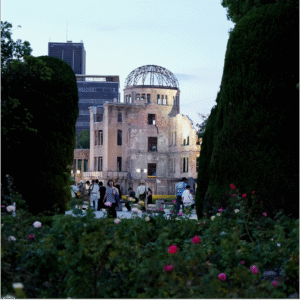18-year-old explains the evolution of Japan’s legal renunciation of warfare

A member of the Japan Ground Self-Defense Force.
Picture by: Keizo Mori | UPI | Alamy
Article link copied.
August 25, 2025
Article 9: Japan’s constitutional ‘pacifist clause’ explained

The recent 80th anniversary of the Hiroshima and Nagasaki bombings has brought renewed attention to Japan’s World War II experiences and to the legacy that still shapes the country’s unique legal position when it comes to war, as one of the most debated and enduring results is Article 9 of Japan’s post-war constitution, the s0-called ‘pacifist clause’.
Harbingers’ Weekly Brief
What Is Article 9 and why was it written?
After the atomic bombings of Nagasaki and Hiroshima in early August 1945, Japan surrendered to the Allied forces. The Americans, who spearheaded the Allies’ efforts that led to Japan’s military capitulation, sought to demilitarise and democratise Japan. A key part of this transformation was drafting a new constitution.
The task largely fell on the General Headquarters (GHQ) under US General Douglas MacArthur. On February 12, 1946, GHQ produced its draft, known as “GHQ Draft” and handed it to the Japanese government the next day. After amendments and revisions, Japan released the ‘Draft for a Revised Constitution’ on April 17, 1946.
What is now known as Article 9 was in all of the drafts and revisions for the post-war Japanese constitution, although in different forms.
It originated from the MacArthur Notes, also known as MacArthur’s Three Basic Points – a set of fundamental principles the US General Douglas MacArthur instructed the Government Section to incorporate into the new constitution. Three points reflected MacArthur’s strong commitment to pacifism and the democratisation of Japan.
These principles specified that “the new Japanese Constitution must prohibit war, dissolve Japan’s feudal structures, and recognise the emperor as a symbolic head of state without political power.”
However, the clause renouncing war was considered unacceptable based on international law as it denied the nation the right to defend itself.
Ultimately, the 1946 version included in the “Draft for a Revised Constitution” reads: “Aspiring sincerely to an international peace based on justice and order, the Japanese people forever renounce war as a sovereign right of the nation and the threat or use of force as means of settling international disputes.
“In order to accomplish the aim of the preceding paragraph, land, sea, and air forces, as well as other war potential, will never be maintained. The right of belligerency of the state will not be recognised.”
Essentially, this piece of the postwar Japanese constitution states that Japan should not create or maintain a military force, renouncing war and surrendering the possibility of future conflicts – adopting a pacifist national identity.
How has Japan interpreted Article 9 over time?
This strict pacifist stance did not last very long. In 1950, the outbreak of the Korean War caused Japan to establish the National Police Reserve, a lightly armed police force of 75,000 people.
In 1952, this was changed to the National Safety Force, followed by the establishment of the Coastal Safety Force. Then, on July 1, 1954, the Japanese Self-Defense Force (JSDF) was formally established.
Since then, and still today, the government faces questions over the legitimacy of this force under Article 9, particularly regarding its interpretation and application.
Today, the SDF readily responds to natural disasters in Japan and abroad and participates in overseas missions.
With increasing global conflicts, such as the dispute in the East China Sea involving China’s gas field development around the contested Senkaku Islands, North Korea’s nuclear threats, and America’s military presence in Japan, the maintenance of a military force is widely understood.
Since WWII, Article 9 has been interpreted in many different ways by different administrations. There is growing discussion and pressure on how Article 9 should be understood and whether it should be reformed.
One key figure pursuing reform was Prime Minister Shinzo Abe, who led Japan and the The Liberal Democrat Party (LDP) from 2006-2007 and again from 2012-2020.
In July 2014, he approved a reinterpretation of Article 9, allowing Japan to exercise the right of collective self-defense, meaning Japan could engage in military action if an ally were attacked.
This was not an official amendment to the constitution, as that would be legally and politically much more complicated, only an interpretation by the then government. The LDP, the biggest party in the Japanese Parliament, strongly supports reforming Article 9, as does its ally, the Komeito Party, although the latter is more cautious.
Opposition comes from parties such as the Democratic Party (DP), the Constitutional Democratic Party (CDP) and the Japanese Communist Party (JCP), all of which strongly resist constitutional reform.
Why is Article 9 controversial?
Public opinion on Article 9 varies widely, and Japanese society is roughly equally divided between those endorsing and opposing the constitutional reform that would significantly alter the clause.
Arguments also vary. Those who would like to see a constitutional reform in Japan address various aspects in which the document of 1947 is outdated, and add that as the constitution was codified during the American occupation, argued that Article 9 was a ‘foreign imposition’ rather than a fully sovereign decision of the Japanese people,
A leading Japanese diplomatic historian, Shinichi Kitaoka, who described himself as a “moderate pro-revisionist,” argued out that Article 9 is inherently flawed: “[T]he first and second clauses contradict with each other. Our renunciation of war was based on the premise that if a situation arises, the United Nations will sanction an aggressor. But the United Nations does not possess its own forces, leading member nations to send their forces to operate under the UN flag. Thus, a UN member state is obligated to possess military power.”
Others, however, perceive Article 9 as Japan’s unique legacy that prevents the country from repeating the militarism that led to World War II and the destruction caused.
The Nobel Peace Prize for Article 9 of the Japanese Constitution campaign argues that the clause should not only be preserved in Japan, but adopted by other countries. “In a world where war has yet to be eliminated, we must recognize and hold high our constitution’s pacifist ideals. Our constitution renounces war, seeking to set an example of reflection on Japan’s past behavior in World War II,” Naomi Takasu argued on behalf of the organisation in an op-ed published by the Council on Foreign Relations.
Written by:

Writer
Bali, Indonesia
Born in 2007 in Malmo, Elias has studied in Sweden, Chile, California, North Carolina, and Bali. He is interested in business, entrepreneurship, management and international relations and plans to study along those lines. For Harbingers’ Magazine, he writes about economics, society, international relations, and sports.
In his free time, Elias plays football, does Maui Thai, goes to the gym, enjoys riding motorbikes and spending quality time with friends and family. He has played high level football his entire life and runs a microbusiness teaching football to young athletes.
Elias speaks English and Swedish.
🌍 Join the World's Youngest Newsroom—Create a Free Account
Sign up to save your favourite articles, get personalised recommendations, and stay informed about stories that Gen Z worldwide actually care about. Plus, subscribe to our newsletter for the latest stories delivered straight to your inbox. 📲
© 2025 The Oxford School for the Future



